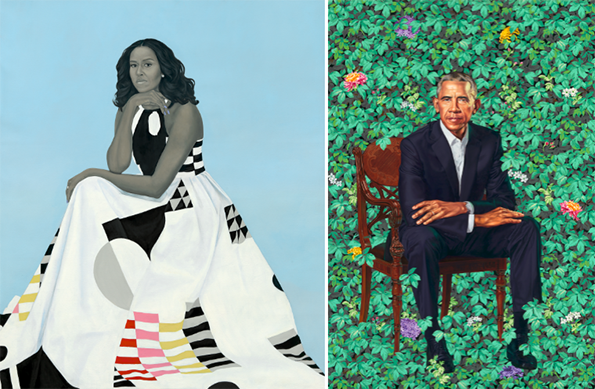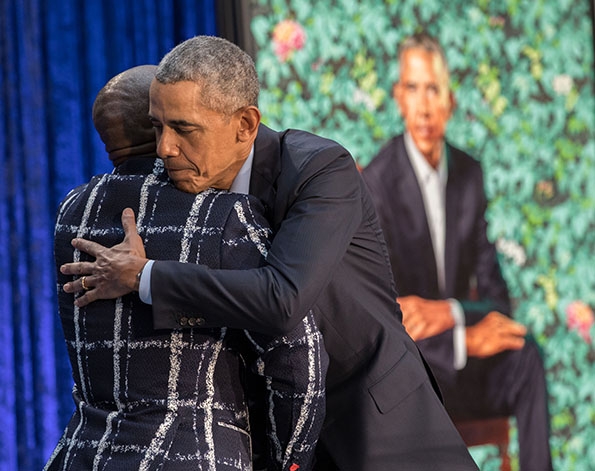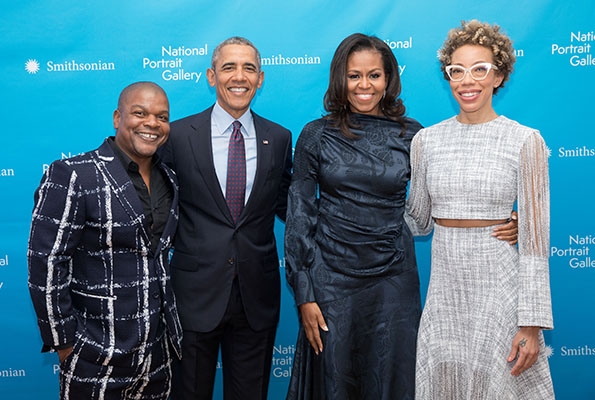The National Portrait Gallery unveils the Obamas’ official portraits.

The official Obama portraits for the Smithsonian’s National Gallery of Art (Photos courtesy of the Smithsonian.)
Art and politics crossed paths early Monday morning at the anticipated unveiling of Barack and Michelle Obama‘s official portraits, commissioned by the National Portrait Gallery. The former president’s painting was done by Kehinde Wiley, known for his bold artistic interpretations of African American subjects and the former first lady’s piece by Baltimore artist Amy Sherald.
Guests gathered in the light-filled Kogod Courtyard, snapping pictures with the fashionably-dressed artists and other luminaries before the director of the Portrait Gallery Kim Sajet (sporting a signature statement necklace) introduced the Obama’s to roaring applause.
The intimate crowd was a who’s who of the Obama administration including former White House Chief of Staff Denis McDonough, all three of Obama’s press secretaries, his trusted advisers David Axelrod and Valerie Jarrett, as well as former Attorney General Eric Holder. Naturally, some celebrity friends of the couple showed face– Gayle King, Shonda Rhimes, Tom Hanks and Steven Spielberg all sat front row. Former vice president Joe Biden chatted with VIP guests across the aisle, including one of the National Portrait Gallery’s commissioners Randi Levine. White House chef Sam Kass and political journalist wife Alex Wagner joined the crowd with their adorably suit-clad infant son. Michelle Obama’s mom Marian Robinson and her brother Craig Robinson were also in attendance.

Portrait unveiling of former President Barack Obama and former First Lady Michelle Obama at the National Portrait Gallery (Photo by Pete Souza.)
In remarks from Smithsonian’s Secretary David Skorton, he reiterated the broad goal of portraiture as an art form: “Presidential portraits have a particular power to capture the public imagination, to move people to think about America’s leaders and indeed American society itself in new and unexpected ways.” Once black cloths were removed from the towering portraits on stage, Skorton’s words rang true. Both Wiley and Sherald’s work reflect the evolution of the American narrative, as mirrored in Obama’s historical presidency.
The event, which in past years has played out as a routine ceremony, felt momentous as portraits showed the first African American couple in the White House by the first African American artists to be commissioned for the task.
The museum currently holds the only complete collection of presidential portraits outside the White House.
The process starts when Portrait Gallery curators make artist suggestions to the president and first lady toward the end of their term, leaving the final choice up to them. Mrs. Obama offered an apology to the other artists who had to go to the Oval Office and “get grilled by the President and the First Lady,” going on to explain that she and Sherald shared a “sister girl” connection that made the decision to work with her simple. Wiley’s artistic style stood out to Obama for the “degree to which [his portraits] challenge our conventional views of power and privilege,” and “the way that he would take extraordinary care and precision and vision in recognizing the beauty and the grace and the dignity of people who are so often invisible in our lives.”
Like most of Sherald’s work, her interpretation of Mrs. Obama is soft and almost dreamlike (many have criticized Sherald’s portrayal as having little resemblance to the first lady). She is pictured sitting coolly and almost contemplative in a billowing geometric gown by Milly. Sherald explained the archetypal nature of her work, emphasizing Mrs. Obama as a representative figure who will influence generations to come. “You exist in our minds and our hearts in the way that you do because we can see ourselves in you,” Sherald said. An “overwhelmed” Mrs. Obama echoed the grand sentiment.
“I’m also thinking of all the young people, particularly girls and girls of color, who … will see an image of someone who looks like them hanging on the wall of this great American institution,” she said. “I know the kind of impact that will have on their lives, because I was one of those girls.”

The Obamas pose with artists Kehinde Wiley and Amy Sherald (Photo by Pete Souza.)
Obama called his grand seven-foot portrait “pretty sharp.” Wiley used his signature vibrant style painting a seated Obama among lush botanicals, several of which point to different parts of his past– African blue lilies representing his Kenyan heritage, jasmine symbolizing his birthplace of Hawaii and chrysanthemums, Chicago’s official flower, connecting to his adult political life. The greenery takes on the symbolism of his past as he leans forward toward his future.
Wiley is well-known for his depictions of African Americans in grandiose settings, and Obama joked that he had to ask him to tone it down for the piece. “‘I’ve got enough political problems without you making me look like Napoleon,'” he said with a laugh.
The president’s portrait will have a permanent home in the Portrait Gallery’s recently renovated “America’s Presidents” exhibition and Mrs. Obama’s will be on view in the recent acquisitions section of the museum through November 2018.




